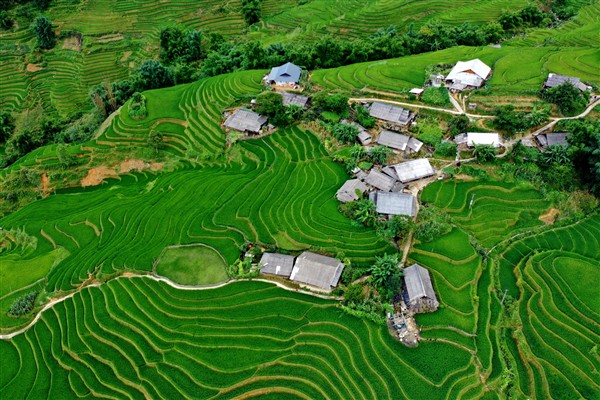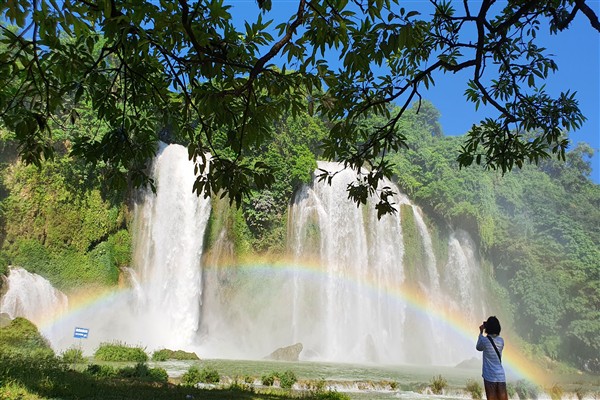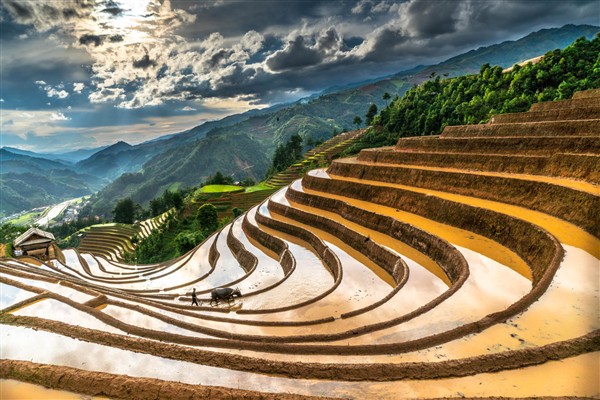Typhoon Season In Vietnam, When It Starts And Ends

Looking at the weather pattern, we can understand that an average of four to six typhoons hit Vietnam annually. The typhoon season usually occurs from May to November, and the most severe typhoons ravage Vietnam from August to October.
The typhoon season generally involves a mix of heavy rains and strong winds. The weather will be horrible in the coastal area and hinder travel plans. Therefore, before planning a Vietnam tour during the typhoon season, you must have all the required data about Vietnam's weather patterns.
How can you make the Vietnam typhoon tour a hassle-free experience? It depends on your preparations and homework before venturing into a Vietnam typhoon tour. While Vietnam's rainy season remains unpredictable, it gives a rare opportunity to enjoy the natural beauty without any adulteration. The refreshing showers increase the level of excitement while exploring the natural beauty of Vietnam and shower you with exciting moments and memorable experiences.
Rainy Season In Vietnam: A General Overview
The rainy season in Vietnam varies across the country’s three regions, each experiencing its unique rainfall patterns and storms. Understanding the timing and nature of the rainy season can significantly influence your travel plans, ensuring you make the most of your visit.
Rainy And Stormy Season In Northern Vietnam
Northern Vietnam’s rainy season occurs between May and October, coinciding with summer and early fall. This period brings hot temperatures ranging from 28°C to 38°C, sometimes even reaching 40°C, marking the year’s hottest season. Rainfall during this time averages about 300 mm, with the monsoon typically lasting 2 to 3 weeks, intensifying between July and October. However, rainfall is not limited to these months, as showers can surprise travelers throughout the season.
In May, light drizzling offers brief relief from the heat. By summer, from July to September, heavy downpours come and go quickly, usually lasting around half an hour. As autumn approaches, light rain can persist for extended periods, sometimes up to 30 days. Tourists must be prepared to experience the weather variations during the rainy season.

Rainy Season In Central Vietnam
Due to climate differences between the East and West, Central Vietnam’s monsoon season is divided into two phases. From September to December, the coastal region expects rain, and the mountainous region gets rain from May to August.
During these periods, heavy rains and storms often cause flooding, which can limit sightseeing activities. However, navigating by small boats during the rainy season will be a pleasant experience. From September to December, cities like Hue and Nha Trang experience heavy rainfall. Heavy rain can be expected in Da Nang and Hoi An from October to December.
Rainy Season In Southern Vietnam
In southern Vietnam, the rainy season typically starts in April and lasts until September or October. The heaviest rainfall occurs between June and August, averaging 250 mm monthly. Another interesting fact is that the heavy rain here lasts for a shorter period, less than three hours, but it can disrupt travel plans. However, the rainy season in South Vietnam is manageable for tourists. Considering all the above facts, South Vietnam will be ideal for tourists planning a Vietnam tour during the typhoon season.
Know All About Vietnam's Typhoon Season
Vietnam's typhoon season, a significant part of its climate cycle, typically spans from June to November, with the most active months being August to October. During this time, coastal regions are particularly vulnerable to heavy rains, strong winds, and potential flooding. Understanding the typhoon season in Vietnam is essential for planning trips, especially if you aim to visit areas like Central Vietnam, which is often the hardest hit.
While the country's weather patterns are shaped by both the southwest and northeast monsoons, the rainy season in Vietnam also coincides with this period, resulting in frequent downpours across many regions. Therefore, tourists planning to visit Vietnam during typhoon season must pay attention to the weather forecasts to make sure for a safe tour.
When Does Typhoon Season Starts And End In Vietnam?
The typhoon season in Vietnam generally starts in early June and ends in late November. During this period, coastal regions, especially in Central and Northern Vietnam, experience the most intense storms, with August through October being the peak months.
Planning a Vietnam tour during the typhoon season requires extra precautions due to the heavy rains, strong winds, and potential flooding. However, carefully selecting travel dates and destinations allows tourists to enjoy Vietnam’s beauty. For those wondering about the best time to visit Vietnam, exploring the southern or northern regions outside of the typhoon months is advisable to avoid weather disruptions.

Things To Know About Vietnam Tour In Typhoon Season.
When planning a Vietnam tour during typhoon season, it is essential to be aware of potential weather disruptions. The typhoon season in Vietnam, which runs from June to November, can bring heavy rains, strong winds, and possible flooding, particularly in coastal areas like Da Nang, Hue, and Hoi An.
Travelers should monitor weather forecasts closely and be flexible with their itineraries to accommodate sudden changes. While typhoon season might not be ideal for beach vacations, it can offer a unique opportunity to experience Vietnam’s vibrant culture and stunning landscapes with fewer crowds. For those preferring more stable weather, the best time to visit Vietnam is during the dry season, from December to April.
How The Rainy Season Affects Travel Plans In Vietnam?
A Vietnam tour in typhoon season, which overlaps with the rainy season, can significantly impact travel plans. Heavy rainfall and occasional storms can lead to flooding, road closures, and transportation delays from June to November, particularly in the Central and Northern regions. While the rain can sometimes be short and manageable, it may disrupt outdoor activities like sightseeing or trekking.
Travelers should have backup plans and stay informed about weather updates. Despite these challenges, visiting during the rainy season offers lush landscapes and fewer tourists. However, for those seeking optimal conditions, the best time to visit Vietnam is between December and April, when the weather is dry and more predictable.
Best Season To Visit Vietnam By Avoiding The Typhoon Season
To make the most of your trip and avoid the typhoon season in Vietnam, planning your visit during the non-typhoon seasons. The typhoon season in Vietnam typically begins in June and lasts until November, with the central and northern regions being more prone to heavy rainfall and storms during this period.
December to April is the best time to visit Vietnam. During this season, the risk of typhoons will be significantly low, and the temperature will be pleasant. During these months, you can explore Vietnam’s stunning landscapes, vibrant cities, and rich cultural heritage without weather-related disruptions.
The Regions Of Vietnam That Mostly Affected By Typhoons
The typhoon season in Vietnam severely affects the northern coastal and central regions. To be precise, areas such as Hoi An, Da Nang, and Hue will face nature's wrath, followed by strong winds and heavy rainfall. Because of that these areas naturally witness heavy deluge.
As in the case of mountainous regions in North Vietnam, the possibility of heavy landslides, an unusual natural calamity where the hill slides down, causes brutal damage to flora and fauna. Northern Vietnam witnessed these types of natural disasters between August and October.
Travelers planning a Vietnam tour during the typhoon season should be aware of these high-risk areas and consider adjusting their itineraries to avoid potential disruptions or weather-related dangers.
The typhoon season will have minimum impacts in Southern Vietnam, so visiting coastal cities in Southern Vietnam is a good and safer alternative for tourists planning to visit Vietnam during the typhoon season.

Safety Tips During Typhoon While Exploring Vietnam
Generally, the best time to visit Vietnam is during the non-typhoon season. However, if you plan for a Vietnam tour during typhoon season, you must pay maximum attention for safety. Also, it is essential to stay tuned to the weather forecasts and head to the advice of authorities and your tour operator. So, it would be better to avoid visiting flood-prone areas.
If you are on a Vietnam tour during typhoon season, ensure your accommodation is secure, and refrain from venturing out during heavy rain or strong winds. Make sure to carry essential supplies, such as water, non-perishable food, and a flashlight, and have an emergency plan. Always keep your travel insurance details handy in case of unexpected disruptions, as well as your medical history details, and make note of medicines that are allergic to you.
Rainy Season And Typhoon Patterns
The rainy season in Vietnam varies across regions, but it generally coincides with the typhoon season, creating distinct weather patterns throughout the country. In Northern Vietnam, the rainy and stormy season runs from May to October, with peak monsoons between July and October, often bringing short but heavy downpours.
Central Vietnam experiences two rainy periods—one from May to August in the mountainous areas and another from September to December along the coast, where severe storms can lead to flooding.
Meanwhile, Southern Vietnam’s rainy season spans from April to September and is characterized by brief yet intense showers, especially in June, July, and August. Travelers embarking on a Vietnam tour in typhoon season should be mindful of these regional weather variations.
How To Plan A Vietnam Tour Around Typhoon Season
Planning a Vietnam tour during the rainy season in Vietnam requires careful consideration to avoid disruptions caused by unpredictable weather. First, it is essential to identify the regions less affected by storms during the typhoon season, such as Southern Vietnam, where rains are short and less likely to disrupt travel. Central Vietnam, on the other hand, is more prone to severe storms between September and December.
Opting for flexible itineraries with indoor activities or cultural experiences can be an intelligent way to ensure your trip remains enjoyable. Travelers should also stay updated on weather forecasts and prepare for last-minute changes if necessary. Booking refundable accommodations and flights is also recommended for trips during the typhoon season in Vietnam to accommodate potential weather-related delays.

Tips For Traveling In Vietnam's Rainy Season
The best time to visit Vietnam is often during the dry season, but preparation is very important if you are traveling in the rainy season. You must check the weather forecast before you plan the trip to avoid unwanted setbacks.
Essentials like hats, raincoats, and waterproof backpacks are necessary, as rain can occur unexpectedly. It would better to opt for lightweight, quick-dry clothing and comfortable sandals to make navigating wet conditions easier. It is also wise to carry medications if you are prone to weather-related issues like allergies or headaches. Protect important documents, like your passport and visa, by storing them in a waterproof bag.
Another crucial item to pack is insect repellent. The increased humidity during the rainy season attracts more insects, making this a must-have. Also, do not forget to pack slippers or waterproof shoes to keep your feet dry.
Should You Travel To Vietnam In The Rainy Season?
The answer is yes, and there are reasons to substation the answer. A visit during the typhoon season in Vietnam offers a unique experience. One of the biggest advantages is the lower travel costs, as fewer tourists visit during this period, allowing you to enjoy good services at a reduced price.
It is also an excellent time to immerse yourself in local culture, as you will witness daily life in a different light, with locals adapting to the rains. The charm of ancient buildings, such as those in Hanoi’s Old Quarter or Hoi An, becomes even more captivating under the rain, offering stunning photo opportunities.
If you are flexible with your itinerary and prepared for unexpected weather, the rainy season in Vietnam can provide a peaceful and culturally rich experience.
Conclusion
Planning a Vietnam tour during typhoon season requires proper preparation. From understanding the regional weather patterns to packing appropriately and staying informed, travelers can enjoy Vietnam’s natural beauty and vibrant culture even during the stormy months.
However, for those who prefer outdoor activities under normal weather, the best time to visit Vietnam is between December and April, when the skies are clear and conditions are more favorable for exploration. Whether you choose to visit in the rainy or dry season, Vietnam offers a unique charm year-round.




























